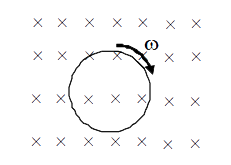The angular speed of earth around its own axis is
π43200rad/s
π3600rad/s
π86400 rad/s
π1800rad/s
The correct Answer is:A
To find the angular speed of the Earth around its own axis, we can follow these steps:
Step 1: Understand the Concept of Angular Speed
Angular speed (ω) is defined as the rate of change of angular displacement with respect to time. It is usually measured in radians per second.
Step 2: Identify the Time Period
The Earth completes one full rotation around its axis in 24 hours. We need to convert this time period into seconds for our calculations.
Time period (T)=24 hours=24×60×60 seconds
Step 3: Calculate the Time Period in Seconds
Now, we calculate the time period in seconds:
T=24×60×60=86400 seconds
Step 4: Use the Formula for Angular Speed
The formula for angular speed is given by:
ω=2πT
Step 5: Substitute the Time Period into the Formula
Now, we substitute the value of T into the formula:
ω=2π86400
Step 6: Calculate the Angular Speed
Now we can perform the calculation:
ω=2π86400≈6.283286400≈7.272×10−5 radians per second
Final Answer
Thus, the angular speed of the Earth around its own axis is approximately:
ω≈7.272×10−5 radians per second
---
Angular speed (ω) is defined as the rate of change of angular displacement with respect to time. It is usually measured in radians per second.
The Earth completes one full rotation around its axis in 24 hours. We need to convert this time period into seconds for our calculations.
Now, we calculate the time period in seconds:
The formula for angular speed is given by:
Now, we substitute the value of T into the formula:
Now we can perform the calculation:
Thus, the angular speed of the Earth around its own axis is approximately:
Similar Questions
Knowledge Check
A satellite moves estwards very near the surface of the Earth in equitorial plane with speed (v0). Another satellite moves at the same height with the same speed in the equatorial plane but westwards. If R =radius of the Earth and ω be its angular speed of the Earth about its own axis. Then find the approximate difference in the two time period as observed on the earth.
A4πωR2v20+R2ω2B2πωR2v20−R2ω2C4πωR2v20−R2ω2D2πωR2v20+R2ω2A train of mass m moves with a velocity υ on the equator from east to west. If ω is the angular speed of earth about its axis and R is the radius of the earth then the normal reaction acting on the train is
Amg[1−(ωR−2υ)ωg−υ2Rg]Bmg[1−2(ωR−υ)ωg−υ2Rg]Cmg[1−(ωR−2υ)ωg−υ2Rg]Dmg[1−2(ωR−υ)ωg−υ2Rg]What should be the angular velocity of earth about its own axis so that the weight of the body at the equator would become 34 th of its present value ?
A1400rads−1B1800rads−1C11600rads−1D13200rads−1
Which is greater : the angular velocity of hour hand of a watch or angular velocity of earth around its own axis ? Give their ratio.
View SolutionA circular coil of radius r is placed in a uniform magnetic field B. The magnetic field is normal to the plane of the coil is rotated at an angular speed of ω, about its own axis , then the induced emf in the coil is __

View SolutionThe angular speed of earth's rotation about its own axis is ω. When its angular speed is increased to n time its original angular speed, the acceleration due to gravity at the equator becomes zero. What is the value of n?
[R is the equatorial radius of the earth]
View SolutionIf earth suddenly stop rotating , then the weight of an object of mass m at equator will [ ω is angular speed of earth and R is its radius . ]
View SolutionThe Earth takes slightly less than one day to complete one rotation about the axis passing through its poles. The actual time is 8.616×104s. With this given information, what is the angular speed of the Earth about its axis?
View Solution
